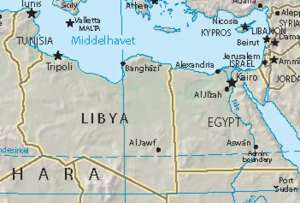Egyptian–Libyan War
| Libyan-Egyptian War (Cold War) | |||||||
|---|---|---|---|---|---|---|---|
 Map of Egypt and Libya | |||||||
| |||||||
| Belligerents | |||||||
|
|
Supporters: | ||||||
| Commanders and leaders | |||||||
| Muammar al-Gaddafi | Anwar as-Sadat | ||||||
| Casualties and losses | |||||||
| Unknown | Unknown | ||||||
The Libyan-Egyptian War was a short border war between Libya and Egypt in July 1977. Tensions between the two countries had increased during April and May 1977 as demonstrators attacked the embassies of both countries. On July 21, 1977 gun battles between troops on the border began, followed by land and air attacks on both sides. A ceasefire was agreed to on July 24, having being organised by Algeria's president.
Timeline
A "march on Cairo" was organized with thousands of Libyan protestors marching towards the Egyptian border in June 1977. The Libyans wanted to demonstrate against Egypt's closer ties with Israel. On 20 July 1977 Libyan artillery units fired at the Egyptians in Sallum, after the protest march was stopped by Egyptian soldiers.
On 21 July 1977 Egyptian armored units and motorized infantry supported by artillery drove into the border area and answered the Libyan artillery fire. Approximately two divisions of the 1st Egyptian army, which were usually stationed around Cairo, were ordered to the Libyan border. The Egyptian Air Force attacked Libyan army bases on the border with Su-20 and MiG-21 combat aircraft. Two radar facilities and an air defense rocket position hidden in an oasis, as well as a rocket position near the Mediterranean coast close to Bardiyah, were destroyed. The Egyptians also bombed an airbase near Benghazi, much further west than the border.
The land campaign went into full effect later that day, as parts of the 3rd Egyptian armored division pushed toward the Libyan city Musaid behind the common border. International press scrambled to cover the growing conflict. The New York Times quoted an Egyptian military spokesman claiming that a Libyan "armored and aerial attack" had failed "with the loss of 40 tanks and 2 planes."[1]
On 22 July 1977 the Egyptian Air Force in a second wave with Su-20 and MiG-21 combat aircraft attacked the Libyan Air Force bases south of Tobruk. Libyan airplanes on the ground were said to have been destroyed according to Egyptian sources. Libyan aircraft from all over the nation scrambled to defend. An Egyptian Mig-21 was shot down by a Libyan SA-7 Grail. The Egyptian sorties pressed on, however, attacking a key Libyan airfield in the oasis of Kufra using fighter planes. Some Egyptian paratroopers were said to have dropped behind the Libyan lines. Capitalizing on the opening of the second front, Egyptian helicopters surprised the Libyan air defense, using electronic counter measures (ECM). The Washington Post reported Egyptian President Sadat as calling these attacks "a lesson (to Qaddafi) he will never forget."[2]
On 23 July 1977 the Egyptian Air Force launched a third wave of attacks on Libyan air installations, targeting for the second straight day the massive air force base south of Tobruk. Again Libyan planes scrambled in defense, this time arriving in the air in full force to intercept. The ensuing dogfight was fierce, with a Libyan Mirage 5DE blasting an Egyptian MiG-21 Fishbed. Many planes broke through the Libyan defense however, and the Air Force base was heavily damaged. Libyan combat aircraft counter-attacked, hitting the Egyptian base Marsa Matruh and other targets near the border.
On 24 July 1977, the Libyans boldly tested the Egyptian air defense net, sending its planes in deeper than ever before. Three Libyan Mirages and a MiG-21 Fishbed were shot by Egyptian interceptors and air defense positions, according to Egyptian data. In addition, an alleged terrorist base in Libya approximately 35 km from the border was destroyed by Egyptian forces.
After the cease-fire, there were some more skirmishes between Libyan and Egyptian fighters, in one of them, two LARAF MiG-23MS engaged two EAF upgraded MiG-21MF to carry western weaponry. The Libyan pilots did the mistake of trying to manoeuvre with more nimble Egyptian fighters, and one MiG-23MS was shot down by Maj. Sal Mohammad, while the other used the speed advantage to escape. [3]
Armistice and aftermath
After mediation by the Arab states Algeria as well as the Palestinian leader of the PLO Yassir Arafat, a cease fire was finally reached. The Egyptian president Anwar al-Sadat gave his force instruction to stop all attacks on 24 July 1977 and agree upon an armistice. The fighting stopped on 25 July 1977. Even after the fighting ended, the rift between Arab states remained, however. Many conservative Arab countries had sympathy for Egypt and Anwar as-Sadat, while the so-called social revolutionary-progressive Arab states endorsed the Libyan attitude under Muammar Gaddafi. The West looked on with disdain. An editorial in the New York Times summed up an American perspective of the war by quoting a Palestinian, "If the Arabs haven't got Israel to fight, they will be fighting each other."[4]
In August 1977 an exchange of the prisoners of war between Libya and Egypt was agreed upon and led to a relaxation between the two states.
Some historians think that this war was a false reason to help Egypt to withdraw many of its forces from the Suez canal area without anger from the Egyptian people.[citation needed]
External links
References
- ^ New York Times, 22 July 1977, p. 1
- ^ Washington Post, 23 July 1977, p. A1
- ^ Libya & Egypt, 1971-1979
- ^ Marvine Howe, "The Arabs Can't Seem to Stop Fighting," New York Times, 24 July 1977, p. E2
